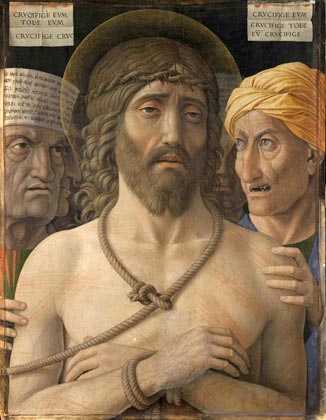The "maniera moderna"
On her arrival in Mantua in 1490 the young Marchesa Isabella judged Mantegna's art out-of-date and flaunted her partiality for a more pleasant and sentimental type of painting. In spite of an evident reticence, the old master's ultimate creations The Adoration of the Magi, Ecce Homo and The Holy Family reveal a more gentle execution and an emotional content which seem to reflect this new climate. At the very end of his life, Mantegna worked on two canvases, the Holy Family with the family of John the Baptist and The Baptism of Christ, for his funerary chapel in the church of Sant'Andrea, a consecration of the social prestige acquired at the end of a long career. On his death in 1506, nobody appears, in Mantua itself, to be able to take over from him, not even his son Francesco.
Even though his beginnings are not well known, it is probable that the tender Correggio spent his formative years in Mantua, in contact with the works of severe Mantegna as can be seen in two early works, the Madonna and Child and The Adoration of the Child. The Holy Family with the Infant John the Baptist which concludes this exhibition, still refers to Mantegna in the formulation of its composition but illustrates Correggio's definitive adhesion to the "maniera moderna", defined by Vasari, that of Leonardo da Vinci and of Raphael.
Andrea Mantegna (Isola di Carturo, circa 1431 - Mantua, 1506)
Ecce Homo
circa 1500
Canvas backed on wood; H. 54 cm; W. 42 cm
Paris, Musée Jacquemart-André, inv. MJAP-P-1840
© 2008 C2RMF / Elsa Lambert









